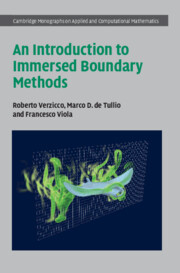Book contents
- Frontmatter
- Dedication
- Contents
- Preface
- 1 Introduction
- 2 Introduction to Flow Simulations
- 3 Computational Geometry and Grid Generation
- 4 Forcing Methods
- 5 Moving Boundaries
- 6 Hydrodynamic Loads Computation
- 7 Fluid–Structure Interaction
- 8 Turbulence and Wall Models within IBMs
- 9 Advanced IBM Applications
- 10 Numerical Examples
- References
- Index
3 - Computational Geometry and Grid Generation
Published online by Cambridge University Press: 30 October 2025
- Frontmatter
- Dedication
- Contents
- Preface
- 1 Introduction
- 2 Introduction to Flow Simulations
- 3 Computational Geometry and Grid Generation
- 4 Forcing Methods
- 5 Moving Boundaries
- 6 Hydrodynamic Loads Computation
- 7 Fluid–Structure Interaction
- 8 Turbulence and Wall Models within IBMs
- 9 Advanced IBM Applications
- 10 Numerical Examples
- References
- Index
Summary
With this chapter, the technical part of immersed boundary methods is initiated. Here it is explained how to define in the most convenient way a complex geometry object and how, after having immersed it in a computational grid, it is possible to determine the position (tagging) of the Eulerian nodes with respect to the boundary of the body.
Several computational geometry theorems are used to design an efficient computational algorithm which makes possible the tagging step within limited CPU time even when the computational grid contains tens of millions of nodes and the immersed object is described by hundreds of thousands of elements. This efficiency is key in problems involving moving bodies, deformable objects or fluid-structure interaction problems.
Information
- Type
- Chapter
- Information
- An Introduction to Immersed Boundary Methods , pp. 33 - 47Publisher: Cambridge University PressPrint publication year: 2025
Accessibility standard: WCAG 2.1 A
Why this information is here
This section outlines the accessibility features of this content - including support for screen readers, full keyboard navigation and high-contrast display options. This may not be relevant for you.Accessibility Information
Content Navigation
Allows you to navigate directly to chapters, sections, or non‐text items through a linked table of contents, reducing the need for extensive scrolling.
Provides an interactive index, letting you go straight to where a term or subject appears in the text without manual searching.
Reading Order & Textual Equivalents
You will encounter all content (including footnotes, captions, etc.) in a clear, sequential flow, making it easier to follow with assistive tools like screen readers.
You get concise descriptions (for images, charts, or media clips), ensuring you do not miss crucial information when visual or audio elements are not accessible.
